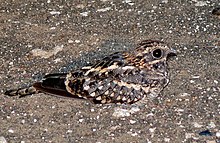Welwitschachtschwalbe
| Welwitschachtschwalbe | ||||||||||
|---|---|---|---|---|---|---|---|---|---|---|

Welwitschachtschwalbe ( Caprimulgus fossii ) |
||||||||||
| Systematics | ||||||||||
|
||||||||||
| Scientific name | ||||||||||
| Caprimulgus fossii | ||||||||||
| Hartlaub , 1857 |
The Welwitschachtschwalbe ( Caprimulgus fossii ) is a species of bird from the family of the nightjar (Caprimulgidae).
It occurs in Botswana , Burundi , Democratic Republic of the Congo , Gabon , Kalahari , Malawi , Mozambique , Namibia , Pemba , Zambia , Zanzibar , South Africa , Uganda , Tanzania .
Their distribution area mainly comprises open tree or bush-covered land, also grassland and sandy areas near the water up to 1800 m.
The German name refers to Friedrich Welwitsch .
description
The Welwitschachtschwalbe is 23–24 cm tall, the male weighs 54–68 g, the female 47–77 g. The upper side including the upper wing is dark gray-brown, spotted with strong gray-white. The main distinguishing feature compared to the nightjar and nightjar is the angular tip of the tail. There are white spots on the side of the throat. The male legs have white spots on the four wings of the hand , a white wing band on the umbrella feathers and narrow white outer tail feathers .
voice
The call of the male is as a whirring with a rising pitch, then breaking off with a "whoop" in flight.
Geographic variation
The following subspecies are recognized:
- C. f. fossii Hartlaub , 1857, nominated form - Gabon
- C. f. welwitschii Bocage , 1867 - mainly highlands , Democratic Republic of the Congo to Namibia
- C. f. mossambicus W.KH Peters , 1868 - Great Plain , Democratic Republic of the Congo to South Africa
- C. f. griseoplurus Clancey , 1965 - Kalahari, also Botswana
Way of life
The diet consists of moths , beetles , grasshoppers , winged termites and ants that are hunted above the ground or above the water.
The breeding season is in June on the island of Pemba, in October on Zanzibar, between September and December in Burundi, Tanzania and Mozambique and between September and November in Malawi and Zambia.
Hazardous situation
The Welwitschnachtschwalbe is not considered endangered ( Least Concern ).
Individual evidence
- ↑ Avibase
- ↑ a b c d e Handbook of the Birds of the World
- ^ A b c T. Stevenson, J. Fanshawe: Birds of East Africa. Kenya, Tanzania, Uganda, Rwanda, and Burundi,, Princeton University Press, 2002, ISBN 978-0-691-12665-4
- ^ IUCN Redlist
Web links
- Videos, photos and sound recordings of Caprimulgus fossii in the Internet Bird Collection
